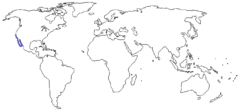Shovelnose guitarfish
| Shovelnose guitarfish | |
|---|---|
| | |
| Dorsal view | |
| | |
| Ventral view | |
| Scientific classification | |
| Kingdom: | Animalia |
| Phylum: | Chordata |
| Class: | Chondrichthyes |
| Subclass: | Elasmobranchii |
| Order: | Rajiformes |
| Family: | Rhinobatidae |
| Genus: | Rhinobatos |
| Species: | R. productus |
| Binomial name | |
| Rhinobatos productus Ayres, 1854 | |
 | |
| Range of R. productus | |
The shovelnose guitarfish, Rhinobatos productus, is a ray in the family Rhinobatidae.[1][2] It becomes mature at an estimated seven to eight years old. Males are between 90 and 100 cm long, while females are around 99 cm at that age.[3] The ray can live up to 11 years, and full-grown sizes are around 120 cm for males, and females reach 137 cm.[4] They range from central California south to the Gulf of California.[5] Morphological and genetic variations occur in the mitochondrial DNA in those found in the Gulf of California, evidencing their isolation from the rest. Because of this, the conservation of this species must be carefully managed to preserve the biological diversity.[6] The shovelnose is considered to be a primitively developed ray, with many features of both sharks and rays.
Rhinobatos productus has magnetic particles in its vestibular receptors, and the magnetic particles believed to be exogenous in origin. The magnetic particles' spatial arrangement may aid in the sensitivity of the receptors to movements.[7]
The visual system of the shovelnose is more extensive and developed than other Elasmobranchii, with multiple large projections connecting to the brain. Almost the entire dorsal and ventral hypothalamus is connected to the visual system, but still maintains a similar lack of differentiation as with sharks.[8]
This species has had one documented case of an attack on a diver when a male guitarfish was interrupted during mating. Because of the tooth structure of the guitarfish, this attack could have resulted in a "gumming" at worst.
The shovelnose guitarfish was first considered to be a shark because of its dorsal fin's shape.
 Shovelnose guitarfish
Shovelnose guitarfish- A 32-inch shovelnose guitarfish caught in the surf
References
- ↑ "Rhinobatos productus". Integrated Taxonomic Information System. Retrieved 24 January 2006.
- ↑ Froese, Rainer and Pauly, Daniel, eds. (2005). "Rhinobatos productus" in FishBase. August 2005 version.
- ↑ Timmons, M and Bray, R. Age, growth, and sexual maturity of shovelnose guitarfish, Rhinobatos productus. Fishery Bulletin 95:349–359 (1997).
- ↑ Timmons, M Bray RN (2004). "Age, growth, and sexual maturity of shovelnose guitarfish, Rhinobatos productus (Ayres)". Fishery Bulletin. 95 (2): 349–359.
- ↑ Márquez; et al. (2005). "Rhinobatos productus". IUCN Red List of Threatened Species. Version 2006. International Union for Conservation of Nature. Retrieved 11 May 2006. Database entry includes justification for why this species is near threatened
- ↑ J. Sandoval-Castillo; A. Rocha-Olivares; C. Villavicencio-Garayzar; E. Balart (2004). "Cryptic isolation of Gulf of California shovelnose guitarfish evidenced by mitochondrial DNA" (PDF). Marine Biology. 145 (5): 983–988. doi:10.1007/s00227-004-1378-7.
- ↑ D.P. O’Leary; J. Vilches-Troya; R.F. Dunn & A. Campos-Muñoz (1981). "Magnets in guitarfish vestibular receptors". Cellular and Molecular Life Sciences. 37 (1): 86–88. doi:10.1007/BF01965587. PMID 7202681.
- ↑ Ebbesson, S.O.E. & Meyer, D.L. (1980). "The visual system of the guitar fish (Rhinobatos productus)". Cell and Tissue Research. 206 (2): 243–250. doi:10.1007/bf00232768. PMID 7388890.
